Housing Starts Finish 2019 Strong with December Increases in Both Single- and Multi-Family Sectors
Single-family housing starts increased 11.2% in December, while the multi-family sector jumped 29.8%.
Total housing starts increased 16.9% in December 2019 to a seasonally adjusted annual rate of 1.61 million units, according to a report from the U.S. Housing and Urban Development and Commerce Department. This represents a 13-year high for housing starts.
The December reading of 1.61 million starts is the number of housing units builders would begin if they kept this pace for the next 12 months. Within this overall number, single-family starts increased 11.2% to a 1.06 million seasonally adjusted annual rate. The multi-family sector, which includes apartment buildings and condos, jumped 29.8% to a 553,000 pace.
Total housing starts for 2019 were 1.29 million, a 3.2% gain over the 1.25 total from 2018. Single-family starts in 2019 totaled 888,200, up 1.4% from the previous year. Multi-family starts in 2019 totaled 401,600, up 7.3% from the previous year.
“The solid housing production numbers are in line with strong builder sentiment, supported by a low supply of existing homes, low mortgage rates and a strong labor market,” said Greg Ugalde, chairman of the National Association of Home Builders (NAHB) and a home builder and developer from Torrington, Conn.
According to Danushka Nanayakkara-Skillington, NAHB’s assistant vice president of Forecasting and Analysis, “The year ended on a high note with solid gains in single-family and multifamily production. And while the December estimates will likely be revised down, the trend moving forward is still positive.”
On a regional and year-to-date basis, combined single- and multi-family starts in December are 3% higher in the Northeast and 8.6% higher in the South. Starts are down 0.8% in the Midwest and 4.7% in the West.
Overall permits, which are a harbinger of future housing production, decreased 3.9% to a 1.42 million unit annualized rate in December. Single-family permits decreased 0.5% to a 916,000 rate, while multi-family permits fell 9.6% to a 500,000 pace. Looking at regional permit data on a year-to-date basis, permits are 13.4% higher in the Northeast, 0.1% higher in the Midwest, 5.1% higher in the South, and 0.1% higher in the West.
For more information, visit www.hud.gov, www.commerce.gov, and www.nahb.org.
Looking for a reprint of this article?
From high-res PDFs to custom plaques, order your copy today!



.webp?height=200&t=1709670950&width=200)

